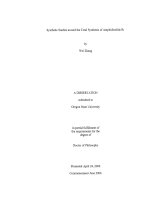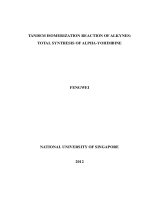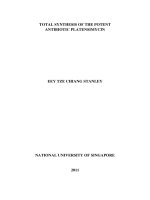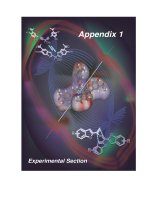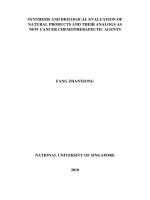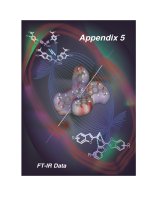Volume 7 the total synthesis of natural products
Bạn đang xem bản rút gọn của tài liệu. Xem và tải ngay bản đầy đủ của tài liệu tại đây (18.4 MB, 473 trang )
THE TOTAL SYNTHESIS
OF NATURAL PRODUCTS
The Total Synthesis
of Natural Products
VOLUME 7
Edited by
John ApSimon
Ottawa- Carleton Chemistry Institute
and
Department of Chemistry
Carleton Universio, Ottawa
A WILEY-INTERSCIENCE
PUBLICATION
JOHN WILEY & SONS
NEWYORK
CHICHESTER
BRISBANE
TORONTO
SINGAPORE
Copyright 0 1988 by John Wiley & Sons, Inc.
All rights reserved. Published simultaneously in Canada.
Reproduction or translation of any part of this work
beyond that permitted by Section 107 or 108 of the
1976 United States Copyright Act without the permission
of the copyright owner is unlawful. Requests for
permission or further information should be addressed to
the Permissions Department, John Wiley & Sons, Inc.
Library of Congress Cataloging in Publication Data:
The Total synthesis of natural products.
“A Wiley-Intersciencepublication.”
Original imprint, v. 1: New York: Wiley-Interscience, 1973.
Includes bibliographical references and indexes.
1 . Chemistry, Organic-Synthesis. I. ApSimon, John.
QD262.T655
1973
547l.2
72-4075
ISBN 0-471-03251-4 (v. 1)
ISBN 0-471-88076-0 (v. 7)
10 9 8 7 6 5 4 3 2
1
ERR AT A
for
THE TOTAL SYNTHESIS OF
NATURAL PRODUCTS, VOLUME 7
Edited by John ApSimon
The names of the authors of Chapter 1 should be as follows in both the contributor list and the table of contents:
K. K. Boeckman, Jr.
S . W. Goldstein
Contributors
to Volume 7
J. Adams, Merck Frosst Canada Inc., Kirkland, Quebec, Canada
J. G. Atkinson, Merck Frosst Canada Inc., Kirkland, Quebec, Canada
Yvonne BessiBre, Borex, Switzerland
R. H. Boeckman, Department of Chemistry, University of Rochester, Rochester,
New York
M. Goldstein, Department of Chemistry, University of Rochester, Rochester,
New York
Y. Guindon, Merck Frosst Canada, Inc., Kirkland, Quebec, Canada
J. Rokach, Merck Frosst Canada, Inc., Kirkland, Quebec, Canada
Alan F. Thomas, Research Laboratory, Firmenich SA, Geneva, Switzerland
R. N. Young, Merck Frosst Canada, Inc., Kirkland, Quebec, Canada
V
Preface
It is always a great pleasure to introduce another volume in this series, signalling
among other things the health of the art and science of organic synthesis.
This volume contains a chapter updating monoterpene synthesis and reviews
the newer areas of leukotrienes and macrocyclic lactones. My grateful thanks
are due to the authors of these contributions for their efforts in producing definitive
work on their specialty areas.
Future volumes in this series are in the pipeline and I am always prepared to
receive suggestions for areas to cover, and offers to help!!
JOHN APSIMON
Otfawa, Canada
January 1988
Contents
The Total Synthesis of Macrocyclic Lactones
1
R. H. BOECKMAN
and M. GOLDSTEIN
Synthesis of the Leukotrienes
141
J. ROKACH,Y. GUINDON,R. N. YOUNG,J. ADAMS,and
J. G. ATKINSON
The Synthesis of Monoterpenes, 1980-1986
275
ALANF. THOMASand YVONNEBESSIBRE
Index
455
ix
The Total Synthesis of Natural Products, Volume7
Edited by John ApSimon
Copyright © 1988 by John Wiley & Sons, Inc.
The Total Synthesis
of Macrocyclic
Lactones
R. K. BOECKMAN Jr. and S.W. GOLDSTEIN
Department of Chemistry, University of Rochester, Rochester, New York
Introduction
1. Simple Monocyclic Macrolides
A. Recifeioltide
B. Diplodialides
C. Lasiodiplodin
D. Curvularin
E. Zearalenone
F. Brefeldin A
2. Antibiotic Macrolides
A. A26771B
B. Methymycin
C. Neomethynolide
D. 6-DeoxyerythronolideB
E. Narbonolide
F. Erythromycins
G. Leucomycin A3 and Carbomycin B
H. Protomycinolide IV
I. Tylosin
1
2
The Total Synthesis of Macrocyclic Lactones
J. Milbemycin p3
3. Polycyclic Macrolides
A. Cytochalasins
B , Hybridalactone
4. Macrocyclic Polyolides
A. Diolides
(1) Pyrenophorin
(2) Vermiculine
(3) Aplasmomycin
B. Macrocyclic Trichothecin Triolides
(1) Vermcarin A
(2) Vermcarin J
(3) Trichovemn B
(4) Roridin E
(5) Baccharin B,
C. Tetralides
(1) Nonactin
References
INTRODUCTION
This chapter in Volume 7 of The Total Synthesis of Natural Products deals
almost exclusively with the total synthesis of naturally occurring macrocyclic
lactones (macrolides), polylactones (diolides, tetrolides, etc.), and their
aglycones. Our use of the term macrolide transcends the original usage where
it was restricted to the CI2-Cl6 macrocyclic lactone antibiotics. Although several
reviews on the synthesis of macrolides have been published,14 these have dealt
mainly with the ring-forming lactonization step. We have attempted to chronicle
the development of total synthesis in this field from the early efforts directed
toward relatively simple targets to the current day assaults on the extremely
complex, highly functionalized members of this class.
The chapter is divided into sections that deal with the various target compounds
in approximate order of increasing complexity. Section 1 deals with simple
monolactones which lack complex substituents such as sugars, esters, and the
like attached to the lactone ring. This section includes primarily compounds that
exhibit little or no biological activity, such as recifeiolide and diplodialide A.
The syntheses in this area are generally quite straightforward and for expedience
we have omitted some of the simplest compounds. The omission of some of
these early studies is not intended to in any way diminish their value, for these
efforts laid the foundations for later advances.
Section 2 deals with the synthesis of the more familiar biologically active
macrolides, including the erythronolides, tylosin, and the leucomycincarbomycin group. These compounds, many of which have important medicinal
Simple Monocyclic Macrolides
3
uses, possess more highly oxygenated ring systems and are linked, via glycosidic
linkages, to one or more sugar units.
Section 3 deals with the polycyclic macrolides such as cytochalasin B and
hybridalactone. These compounds also exhibit profound biological activity. Since
they are substantially more complicated than the other monolactones, we felt a
separate section was warranted.
Section 4 deals with the total synthesis of macrolides having more than one
lactone linkage in the macrocyclic ring. Compounds included in this group range
from the dimeric lactone pyrenophorin and the trichothecanes to the tetrameric
lactone nonactin.
Throughout this chapter we have attempted to be as comprehensiveas possible
in our coverage of the literature through 1984, with selected coverage of early
parts of 1985 in the broad area of macrolide total synthesis. However, we have
very possibly overlooked some work in the area. We regret the oversight, and
we wish to apologize in advance to any workers in the area whose efforts have
been inadvertently omitted.
1. SIMPLE MONOCYCLIC MACROLIDES
A. Recifeiolide
Recifeiolide (l),one of the simplest naturally occurring macrocyclic lactones,
is isolated from the fungus Cephalosporium recij?ea5Since only one chiral center
is present in this molecule, recifeiolide is the common benchmark for macrolide
methodology. The first synthesis of this compound, by Corey’s group at Harvard,
began with 4-hydroxy-1-pentyne(2) (Scheme 1.1).6 Protection of the alcohol as
the THP ether followed by hydrostannation afforded a 8515 mixture of vinyl
stannanes 3 with the (E)-isomer predominating. The stereospecific conversion
of the stannanes 3 to the corresponding vinyl cuprates 4 was achieved by
metalation with n-butyl lithium followed by quenching into pentynyl copper.
The cuprates 4 were then coupled with either 7-iodo-heptanitrile or ethyl 7iodohepanoate and the alcohol protecting group was removed to afford a 5 6 5 6 %
yield of alkylated products 5a or 5b. At this stage, chromatographic separation
Figure 1.1. Recifeiolide (1).
4
The Total Synthesis of Macrocyclic Lactones
of the olefin isomers yielded Q-5a or (E)-5b, which encompass all the required
carbons for conversion to 1. Alkaline hydrolysis gave the key intermediate seco
acid 6 (98%). The final cyclization was accomplished by conversion to the
2-thiopyridyl ester and subsequent thermolysis in dilute xylene to afford
recifeiolide (1) in 52% overall yield from 6.
b X-CN
& X-C02Et
B
Scheme 1 . 1 . Corey’s recifeiolide synthesis.
The same year, Gerlach described a synthesis of optically active 1 from
(R)-l,3-butanediol (7)(Scheme 1.2).’ The diastereomeric esters produced from
( - ) camphorsulfonyl chloride and racemic 1,3-butanediol were fractionally
recrystallized and then hydrolized to afford enantiomerically pure 7. Tosylation
of the primary alcohol, displacement with sodium iodide, and conversion to the
phosphonium salt 8 proceeded in 58% yield. Methyl-8-oxo-octanoate(lo), the
ozonolysis product of the enol ether of cyclooctanone (9), was subjected to
Wittig condensation with the dilithio anion of 8 to give 11 as a mixture of olefin
isomers in 32% yield. The ratio, initially 68:32 (E:Z),was easily enriched further
by photolysis in the presence of diphenyl disulfide. The synthesis
to 83:17 (EZ)
was then completed by hydrolysis of the ester to the seco acid, conversion to
the 2-thiopyridyl ester, and silver-mediated ring closure to afford 1 (70%).
Gerlach’s synthesis, while producing the optically active natural product, still
did not address the problem posed by the olefin geometry.
A third approach employing lactonization as the final step was published by
Mukaiyama in 1977 (Scheme 1.3).’ Alcohol 2 was protected as the THP acetal
and alkylated with a protected 7-bromoheptanol to give diol 12 in 52% yield
following acidic deprotection. As 12 contains all of the required carbon atoms
for conversion to the target 1, the remaining steps involve only the manipulation
of the oxidation states of the various functional groups and the final lactonization.
Accordingly, a series of straightforward oxidations and a reduction then allowed
the isolation of hydroxy acid 13 in 50% yield. Lithium metal reduction of the
Simple Monocyclic Macrolides
I
5
W
u
I ) KOH, M*OH
2) (C6H4NS)2
“3P
3) A&I04
1
Scheme 1.2. Gerlach’s recifeiolide synthesis.
alkyne then furnished the seco acid 6 in 53% along with a small amount of the
corresponding amide 14, which was readily hydrolized back to 6. Lactonization
involving a double activation sequence furnished an 87% yield of 1.
H/T::::Yb
OH
3) BrlCH210THP
-
6
HO I CH2) 7
4 ) H*,HgO
2
L”NHS
____*
(
J
u \
H02C-lCH2)o
3)NaBH4
12
l
2
;;m;;;;,PYrj
)
I
~
I-
c
yJhG
l
2“
+
ELfN
KOH,H202
2) H*
7
OH
0
w
ll
’
0
1
Scheme 1.3. Mukaiyama’s recifeiolide synthesis.
The aforementioned method for carboxyl group activation proceeds via intermediate 6a, which is then subjected to an intramolecular attack by the secondary
alcohol. Among the noteworthy aspects of this synthesis were the rapid entry
into the system and the specific formation of the (@-olefin geometry.
Utimoto and co-workers have successfully achieved a concise synthesis of
the optically active seco acid 6 beginning with 1-nonen-8-yne(15) (see Scheme
1.4).’ Hydroalumination of enyne 15 with Dibal and conversion to the alanate
with n-butyl lithium, followed by treatment with (R)-propylene oxide afforded
6
The Total Synthesis of Macrocyclic Lactones
an
Figure 1.2.
alcohol 16 in 55% yield. Not surprisingly, the syn hydroalumination step produced
>99% of the (Q-internal olefin. Protection of the alcohol as the THP ether
followed by hydroboration and oxidation gave the monoprotected dioll7 (74%).
Seco acid 6 was obtained following a Corey-Kim oxidation, acidic hydrolysis
of the THP ether (75%), and subsequent silver oxide oxidation (98%). The
conversion of 6 to recifeiolide (1) then followed the Gerlach procedure.’
2) nBuli
15
-
1) Corey-Kim [a]
1) OHP, H*
1) DiBAl
2) R28H
3) NaOH, HzOz
16
3) Ago
17
-
d
Scheme 1.4. Utimoto’s recifeiolide synthesis.
A novel method of stereospecific olefin formation was used by Tsuji for the
elaboration of intermediate 18 (Scheme 1.5). lo Palladium(I1)-mediated
telomerization of butadiene in nitroethane gave a 56% isolated yield of the
(0-nitro olefin 18. One rationale for the high stereospecificity in the bondforming steps of this reaction arises from an examination of the mechanism. The
addition of Pd+2 to butadiene causes initial formation of a dimeric bis n-ally1
palladium species. The bis n-ally1 species 18a and the a-ally1 species 18b (Eq.
1.1) are in rapid equilibrium and the latter intermediate may be intercepted by
a nucleophile. Thus the addition of nitroethane to 18b results in the formation
of 18c with retention of the (Q-olefin geometry. Reductive elimination of
palladium then produces 18 with retention of the (E)-olefin geometry.
After conversion to 19 (70% yield) via Nef reaction and ketalization, selective
modification of the terminal olefin by reaction with LAH-TiCl,, quenching with
12, and displacement of the resulting terminal halogen with ethyl acetoacetate
anion afforded 20 in 48% overall yield. Deacetylation with sodium ethoxide
followed by deketalization under acidic conditions produced an 88% yield of
keto ester 21. Seco acid 6 was then obtained (in 29% yield from 18) after
reduction of the ketone and ester hydrolysis. Clearly, the significance of this
Simple Monocyclic Macrolides
NO*
CH~CHNO~
LBh
7
FBC
(1.1)
Telecomerization of butadiene
synthesis was the utilization of inexpensive starting materials and the excellent
specificity of the olefin-forming reaction. Tsuji has employed this methodology
for the synthesis of several other natural products.
-
'2
P
21
0
Scheme 1.5. Tsuji's first recifeiolide synthesis.
The second Tsuji synthesis, which appeared (see Scheme 1.6) in the latter
part of 1978, employed a strategy similar to his earlier work for construction of
the basic carbon framework.'' Ketal diene 19 was transformed to halo alcohol
22 by the use of chemistry established in his previous synthesis." Acylation
with phenylthioacetylchloride readily afforded ester 23. Intramolecularalkylation
resulting in ring closure was brought about by deprotonation with sodium hexamethyldisilazane to give lactone 24 in 71% yield. Synthetic 1 was then obtained
in 90% yield following Raney nickel reduction.
Kumada's group at Kyoto installed the (Q-olefin required for recifeiolide (1)
via syn addition to a terminal acetylene (Scheme 1.7). l 2 Beginning with methyl
8-nonynoate' chloroplatinic-acid-catalyzed addition of trichlorosilane gave the
corresponding Q-silyl olefin. Halogen exchange and formation of the silicate
with aqueous KF afforded 25 in 62% yield. Alkylation with ally1 chloride
mediated by P ~ ( O A C gave
) ~ diene 26, which was transformed by Wacker
oxidation to ketone 27 (37%). This completed a formal total synthesis of 1, as
the conversion of 27 to the natural product had previously been achieved by
Tsuji. lo Although somewhat suggestive of Utimoto's approach, the Kumada
8
The Total Synthesis of Macrocyclic Lactones
@rSph
b
-
24
I
Scheme 1.6. Tsuji’s second recifeiolide synthesis,
synthesis was less complicated, since fewer oxidation state changes and protecting
group manipulations were required.
W
u
Scheme 1.7. Kumada’s recifeiolide synthesis.
By far the most concise synthesis of 1 has arisen from the work of Schreiber
in 1980 (see Scheme 1.8).13The lithium enolate 28 was monoalkylated with
propylene oxide in the presence of trimethyl aluminum to give keto alcohol 29
in 96%yield (based on recovered 28). The addition of hydrogen peroxide under
acidic conditions then made available the hydroperoxide 30 in 99% yield. A
ferrous-ion-induced fragmentation then gave the natural product 1 in 96% yield
as a single olefin isomer.
The mechanism of the key fragmentation involves initial transfer of an electron
to hydroperoxide 30 (Eq. 1.2) from Fe+*, forming intermediate30a, which then
cleaves homolytically to the carbon radical 30b. Oxidative coupling with
Cu(OAc), then forms 30c in which the ester moiety is in the stable Zconfiguration, stabilized by internal coordination via a psuedo six-membered
ring. From this intermediate, only one hydrogen atom (HA)
is available for syn
elimination and, accordingly, only the (@-olefin is produced.
LiO
aA
Al(CHal3
28
Fd04
Cu(0Ac )2
-"Simple Monocyclic Macrolides
9
H 0 ,HOAc
OOH
z0
a
Go
'
I
Scheme 1.8.
Schreiber's recifeiolide synthesis.
cu'2
Trost chose to exemplify the utility of organopalladium coupling reactions
for carbon-carbon bond formation by use of this process for the ring closure
step in a synthesis of 1(Scheme 1.9).l4 To this end, monoprotected diol31 was
oxidized and chain extended to form the a$-unsaturated ester 32. Reduction to
the allylic alcohol followed by acetylation and desilylation gave 33 in 53%
overall yield from 31. Carboxylic acid 35 was then obtained via a two-step
sequence from bromo ester 34 (84%) by alkylation with methyl
r 4
- Do Go
I ) PCC
G
C
0
2
E
L
u
NaH
I
Lolo
AcC1,pyr.
3 ) H20,H*
;L;1
C02CH3
Na
I ) PhSOpiHCO2CH3
C02CH2CCI3
Br
I ) DlBAl
2)
2 ) (E10)2POCH2C02EL
8) Zn
I ) S0Cl2
6
8
.
P
.
2) P
'
A
O
O
J
T
HJCO~C
S02Ph
;u
a6
9B
;:wP*'.
Pd(NaH
Ph3P)
H3C02C
S02Ph
u
1
Scheme 1.9. Trost's recifeiolide synthesis.
0
10
The Total Synthesis of Macrocyclic Lactones
phenylsulfonylacetate followed by reductive cleavage of the ester. Formation of
the analogous acid chloride permitted coupling of 35 and 33 to afford ester 36
in 79% yield. Formation of the 12-membered ring lactone was then achieved by
palladium-catalyzed cyclization to afford 37 (78%), with no apparent formation
of either any (9-olefin or 10-membered ring lactone. The stereospecificity of
this reaction is quite dramatic when compared with the loss of olefin geometry
observed in acyclic cases.15 The synthesis of 1 was efficiently completed by
decarboalkoxylation and reductive desulfonylation to give synthetic 1 in 8 1%
yield. Although this synthesis is somewhat complex for a molecule as structurally
simple as 1, clearly Trost selected recifeiolide as a vehicle to explore methodology
useful for the construction of more complex macrolides.
Wasserman has completed two syntheses of recifeiolide, both employing the
use of oxazoles as acetic acid dianion equivalents.16 The first (Scheme 1.10)
utilized a route previously developed by Corey6 for his synthesis of 1. Cuprate
4 was alkylated and then converted to iodide 38 in a straightforward manner.
Alkylation with oxazole anion 39 and removal of the THP with acid then led
directly to alcohol 40. Liberation of the carboximide moiety was achieved by
treatment with singlet oxygen to afford 41, which led to the isolation of synthetic
1after an acid-mediated lactonization step, and separation of the olefin isomers.
Scheme 1.10. Wasserman’s first recifeiolide synthesis.
Wasserrnan’s second synthesis, l6 shown in Scheme 1.11, was similar to a
strategy utilized by GerlachO7Anion 39 was alkylated with the acetal of 6iodohexanal and deprotected to produce aldehyde 42. A Wittig condensation
with the dilithio dianion of racemic 8 afforded the known intermediate 40 as an
8:2 mixture of
and (9-olefin isomers, respectively.
The most recent synthesis of 1 is that of Bestmann.17 Acetylenic alcohol 2
was converted to the dianion and alkylated with the acetal of 4-bromopentanal
to give alkyne 53. Subsequent reduction of the triple bond with sodium in
ammonia generated exclusively the required @‘)-olefin geometry. 0-Alkylation
(a-
Simple Monocyclic Macrolides
11
of the intermediate alcohol with ketenylidenetriphenylphosphorane(44) then
afforded the stabilized Wittig reagent 45. Cleavage of the acetal with acid followed
by base treatment to regenerate the stabilized ylide induced an intramolecular
Wittig condensation which provided the a$-unsaturated lactone 46. Finally,
selective reduction of the conjugated double bond was achieved with Redal and
CuBr to afford 1.
0
I ) HCI
2 ) pH 8 . 4 ’
48
-
RED-AI C u b
1
Scheme 1.12. Bestmann’s recifeiolide synthesis.
B. Diplodialides
The diplodialides are a family of ten-membered ring macrocyclic lactones isolated
from the pathogenic fungus Diplodia pinea. Structural studies by Wada in 1976
had shown these compounds to be quite similar to recifeiolide (l),with an
additional oxygen functionality included p to the lactone carbonyl. l 8
Diplodialides A, B, C, and D (47-50) are the four most common members of
this group.
The first synthesis of these compounds was also that of Wada in 1977 (Scheme
1.13).l9 Ethyl 5-oxohexanoate (51) was reduced with NaBH4 and the resulting
alcohol protected with dihydropyran to give 52. Reduction of the ester moiety
to a primary alcohol followed by conversion to the bromide 53 was achieved by
conventional means. Alkylation of the dianion of ethyl acetoacetate with 53
afforded a 78% yield the p-keto ester 54, which possesses all the carbons required
for the construction of the diplodialides. Protection of the ketone as the dithiane
The Total Synthesis of Macrocyclic Lactones
12
9
CH3
HO
HO
0
Figure 1.3. Diplodialide A (47); B (48);C (49);D (50).
using BF,-Et,O and ethanedithiol, which caused concomitant cleavage of the
THP ether, followed by basic hydrolysis of the ethyl ester, furnished acid 55
(72%). Lactonization using the Corey procedure afforded macrocycle 56 in 30%
yield. Removal of the dithioketal with NBS in water gave an 82% yield of the
keto lactone 57. The double bond was then introduced by a selenylation-oxidation
sequence. Accordingly, treatment of 57 with excess LDA followed phenylselenyl
bromide afforded selenyl lactone 5,8a (17%), the desired 58b (23%), and
L
C
0
2
E
t
2)
I ) NoBH4
OHP,H+
61
62
C02Et
- 0
’
OTHP
/I/VC02Et
I ) fCsH4NS)2
1 ) H8CH2CH2SH, BF3
2 1 KOH, MaOH’
2 ) HEAT
66
u
Scheme 1.13. Wada’s diplodialide A synthesis.
’
Simple Monocyclic Macrolides
13
recovered starting material 57 (41%). Undesired 58a was readily reconverted to
57 in 71% yield with Raney nickel. Synthetic diplodialide-A (47) was then
obtained from 58b in 59% yield after oxidation and selenoxide elimination.
The following year, Tsuji published a synthesis of 47 utilizing the now familiar
butadiene telomerizationtechnique (Scheme 1. 14).20When butadiene was reacted
in the presence of Pd(OAc), and acetic acid, diene acetates 59a and 59b were
formed. The desired terminal acetate 59a was easily separated from a small
amount of the isomeric 59b by fractional distillation. Conversion of the terminal
olefin into what will subsequently become the secondary alcohol was achieved
by Wacker oxidation which produced ketone 60 (77%). After substitution of a
THP ether for the acetate, the ketone was reduced and the resulting alcohol was
acylated with bromoacetyl bromide to afford 61. Acidic cleavage of the THP
ether followed by oxidation then provided ester aldehyde 62.Final ring closure
was achieved using a modified version of the Reformatsky reaction. Thus
treatment of 62 with zinc and diethylaluminum chloride gave 48 as a mixture
of alcohol diastereomers in 45% yield. Oxidation of the allylic alcohol with
Mn02 then afforded synthetic 47.
2
Pd(OAo)2
HOAo
+
k 0
I ) Zn, EL2AICI
___*
21
nno2
2
PdCI2 CuCI2
o2 n20
0
9
Scheme 1.14. Tsuji's diplodialide A synthesis.
The studies of Ban and Wakamatsu culminated in the preparation of three
natural compounds from a single synthetic route (Scheme 1.15).'l The enediol
bis silyl ether 63 was converted to the dianion and immediately alkylated with
1-iodo-3-butanol to give glycol 64 as a mixture of diastereomers in 87% yield.
Diol fragmentation with lead tetraacetate afforded keto lactone 65 in quantitative
yield. Formation of the dithioketal and subsequent Raney nickel desulfurization
then gave 66 (81%). Macrocyclic lactone 66 is the simple natural product
The Total Synthesis of Macrocyclic Lactones
14
Phorcantholide I, isolated from the metasternal gland secretion of Phoracantha
synonyma.
Oxidation f3 to the lactone carbonyl, which is required to obtain the diplodialide
system, was then effected via the following two reaction sequences. Selenylationelimination furnished the unsaturated lactone 67 (82%). Epoxidation of 67
followed by lithium-ammonia reduction gave diplodialide-C (49) and the
diastereomeric alcohol 68 in 4045%yield from the mixture of f3- and a-epoxides,
respectively. For the preparation of 47, the intermediates 68 and 49 were not
isolated, but rather directly oxidized to provide P-keto lactone 69 (63% from
67). Formation of the vinylogous ester, followed by allylic bromination, led to
the diastereomeric halides 70 in 81% yield. Displacement of bromide by the
phenylselenyl anion produced the intermediate selenolactones which were
subjected to oxidation and selenoxide elimination to dienes 71a and 71b. At this
point in the synthesis, the assignment of olefin geometry in 71a and 71b was
not possible; however, the sequence was stereospecific since each diastereomer
of bromide 70 produced a single olefin isomer. Treatment of 71a with
trifluoroacetic acid at - 20°C produced synthetic 47 in 72%yield, thus confirming
the y,&double bond in this isomer was of the (,?+geometry, as required. Similar
treatment of 71b gave a 7:5 ratio of 47 and 72 (44%),the former presumably
from isomerization of the kinetic (a-olefin, along with unchanged 71b (56%).
I) 2.q. M.LI
2) CH3CHOH(CH2)21
OH
I
M
86
HO
I ) H.2SD,
2) HE8
OHDO
0
'
CH30
___,
0
HO'"'
+-
lFA
TFA
u
0
2) L I / N H 3
3) H,O,
-4)3
0
HSCH2CH2SH, EF3
2) Ra-NI
___,
I ) LDA
2) P h h E r
CHID
I)
PbCOAc),
0
22
Scheme 1.15. Ban's diplodialide A and C synthesis.
2I )) PhSw
H*02
Simple Monocyclic Macrolides
15
Ireland utilized a sulfide ring contraction process for the ring-forming step of
his synthesis of 47 (see Scheme 1. 16).22The diethyl acetal of 5-hydroxyhexanal
(73)was converted to the trichloroethyl carbonate and the acetal hydrolized to
produce aldehyde 74 in 86% yield. Addition of the zinc enolate of N,Ndimethylethanethioamide (75) to 74 then afforded an intermediate hydroxy
thioamide which was subjected to acylation and reductive carbonate cleavage to
yield 76 (53%). Acylation with chloroacetyl chloride was followed by ring
closure to give the macrocycle 77 (24%).
'
z5
GCHo
'
OCOCH CCI
I ) tb2NC8CH2- ZnCl'
2 ) AcCl
3 ) Zn HOAo
w
I ) CICH2C0CI
2 ) NaI
b
P(OEt)3
0
( I Pr b2NEt
zl
u
Scheme 1.16. Ireland's diplodialide A synthesis.
The multistep ring-closure process, for which a plausible mechanism is
outlined in Eq. 1.3, involves initial alkylation on sulfur in the thioamide 76a to
give the thioimmonium ion intermediate 76b.Deprotonation forms the episufide
76c,from which sulfur is extruded by the phosphine leading to enamine 76d.
Hydrolysis of the enamine then produces the P-dicarbonyl compound 77.
Elimination of acetic acid from 77 then afforded diplodialide-A (47)in 80%
yield. Although requiring very few steps, the crucial ring-closure reaction
proceeded in disappointingly low yield.
16
The Total Synthesis of Macrocyclic Lactones
Gerlach has successfully prepared both diplodialides A and B (4743) from
a common macrocyclic intermediate, as shown in Scheme 1.17 .23 The THP ether
of 4-bromo-2-pentanol(78) was alkylated with the lithium anion derived from the
protected propargyl alcohol 79 to give, following mild acid hydrolysis, 80 in
76% yield. The LAH reduction of the acetylenic bond in 80 followed by oxidation
to the enal81 proceeded in -75% yield. Homologation of 81 using the lithium
enolate of t-butyl thioacetate then furnished an 81% yield of allylic alcohol 82.
Protection of the free alcohol in 82 either as the t-butyldiphenylsilylether or the
trimethylsilylethyl carbonate, and acidic cleavage of the THP group gave 83 in
81-83% overall yield. Cyclization was achieved by initial conversion to the acid
followed by silver-mediated ring closure via the 2-thiopyridyl ester to afford a
mixture of diastereomeric lactones 84a and 84b in 56% (R = t-butyldiphenylsilyl)
or 1 1% (R = trimethylsilylethoxycarbonyl)yields, respectively, Diastereomer
84a (with either protecting group) was readily converted to synthetic diplodialideB (48) in excellent yield. Diplodialide-A (47) was isolated in good overall yield
following the deprotection of either 84a or 84b and subsequent allylic oxidation.
u
Bp
3) AgCIO,
nEu,NF
I
40
91
Scheme 1.17. Gerlach's diplodialide A and B synthesis.
Simple Monocyclic Macrolides
17
C. Lasiodiplodin
The culture filtrates of the organism Lasiodiplodia theobromae afforded a plant
growth inhibitor which was identified as lasiodiplodin (90) after structural
studies,% From a retrosynthetic viewpoint, construction of the aromatic residue
of 90 (a resorcinol ester) lends itself quite nicely to methodology involving
addition of an acetoacetate moiety to a functionalized olefin. Different variants
of this strategy are employed in the following syntheses of 90.
00
Figure 1.3A. Lasiodiplodin (W).
Gerlach initiated his synthetic route (Scheme 1.18) by condensation of 11hydroxy-Zundecenoic acid methyl ester (85) with methyl acetoacetate under
basic conditions to give the vinylogous methyl ester.25 Further treatment with
benzyl alcohol then gave the corresponding benzyl compound 86 in 48% yield.
This readily available dialkyl cyclohexenone contains the basic framework
required for the construction of the lasiodiplodin system. Oxidation of 86 to the
related phenol via a selenylation-oxidation-elimination sequence and protection
as the methyl ether afforded 87 in 60% overall yield. A point well worth noting
is the differentiation of the two phenolic hydroxy groups in 87, a requirement
that is an impediment in some of the syntheses which will be discussed
subsequently. Oxidation of 87 to the corresponding aldehyde and addition of
methyl Grignard reagent provided 88 (66%). Lactonization was effected via the
methodology previously employed by Gerlach to give macrocycle 89 in good
yield. Hydrogenolysis of the benzyl ether then gave lasiodiplodin (90) in 83%
yield.
Tsuji has completed a synthesis of 0-methyl lasiodiplodin (97), a simple
analog of the natural product 90.26While 97 itself is not found in nature, the
strategy is closely related to those employed for 90 and thus the preparation of
97 is also discussed in detail (see Scheme 1.19).
Methyl acetoacetate was condensed with diketene under basic conditions to
give the resorcinyl ester 92 in 45% yield. Formation of the monomethyl ether
followed by benzylic bromination afforded a 51% yield of 93. The remaining
18
The Total Synthesis of Macrocyclic Lactones
- F,co2H.ok no+
H2 Pd-C
I ) PCC
88
BB
no
89
Scheme 1.18. Gerlach's first lasiodiplodin synthesis.
functionalization of the aromatic ring was achieved by methylation of the residual
phenolic hydroxyl group, substitution at the benzylic position with thiophenoxide,
and basic hydrolysis of the ester to furnish acid 94.
The acyclic carbon framework was derived from Tsuji's previous work on
the telomerization of butadiene. Thus allylic acetate 60 was converted to the
related allylic chloride and the carbonyl was reduced to give 91 in good yield.
Conversion to benzoate ester 96, obtained by conversion of 94 into the
corresponding acid chloride 95 followed by addition of alcohol 91, then set the
stage for macrolide formation. This cyclization was effected by deprotonation
and intramolecular alkylation at the benzylic position in 419% yield.
Desulfurization and concomitant reduction of the olefin then provided 0-methyl
lasiodiplodin (97) in 68% yield. Although Tsuji was readily able to construct
the six-membered ring at the proper oxidation level, the symmetry implicit in
this strategy precluded the required differentiation of the phenolic hydroxyl
groups.
Danishefsky has exploited his widely utilized silyloxydiene chemistry to
complete a formal total synthesis of 90 (Scheme 1.20).*' By employing the
appropriate oxidation levels for both the diene and dienophile, a resorcinyl ester
possessing the required differentiation of the phenolic groups was obtained
without further oxidative manipulation. To this end, the dianion of propiolic
acid was alkylated with 1-bromo-7-octene to give acid 98 in 68% yield. Further
alkylation with methyl iodide then gave the ester 99. A Diels-Alder reaction
with diene 100, a derivative of methyl acetoacetate, and alkyne 99 then furnished
an initial phenolic intermediate which was protected as the benzyl ether to afford

